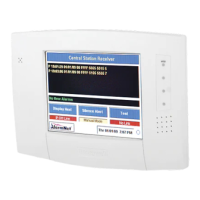
Do you have a question about the Honeywell AlarmNet 7810iR-ent and is the answer not in the manual?
| Power Supply | 12V DC |
|---|---|
| Encryption | AES |
| Compatibility | Honeywell Security Systems |
| Communication | IP and GSM |
| Frequency | GSM: 850/1900 MHz |
| Operating Temperature | 32°F to 120°F |
| Communication Protocol | AlarmNet |
| Certifications | UL |
Details the AlarmNet Enterprise application, its security features, and network configuration for delivering alarm messages.
Explains the AlarmNet-i application for secure alarm message delivery to central stations via broadband internet.
Describes private key encryption using Blowfish or AES for securing alarm data transmission.
Covers additional processes for encryption in enterprise installations and the 7810iR-ent's server function.
Explains the 10-digit key used for encrypting subscriber device keys during registration in enterprise mode.
Details the process for recovering accounts after 7810iR-ent hardware failure in Private LAN mode.
Describes the 7810iR-ent as the receiver for AlarmNet system, handling Contact ID and High Speed messages.
Explains the function of a backup receiver for uninterrupted alarm reporting in Private LAN configurations.
Lists key features of the 7810iR-ent, including its interface, message format support, and automation modes.
Provides instructions for physically mounting the 7810iR-ent unit, including rack mounting.
Specifies the necessary DC power input (12VDC, 500mA) and UL/ULC compliance for power supplies.
Details standalone operation for receiving Contact ID or ADEMCO high-speed messages, requiring operator intervention.
Describes passing alarm messages to a 685 Digital Alarm Receiver or MX-8000 receiver via an LRR line card.
Explains routing alarm messages directly to automation equipment using an RS232 serial interface.
Covers connecting and configuring Okidata Microline 320 serial printers for report logging.
Details the required configuration settings for the serial printer (baud rate, data bits, parity).
Provides a pinout summary for connecting the 7810iR-ent to a serial printer.
Shows examples of output text from the serial printer for different operational modes.
Describes the 7810iR-ent's Graphical User Interface, including the New Alarm and Alarm History windows.
Explains how to navigate through the device's interface using touch screen buttons and menu options.
Outlines programming limitations required for UL 864 compliance for fire alarm systems.
Guides on configuring the 7810iR-ent for a Private LAN setup, including account and network settings.
Details the process of using an Installation Key to install multiple 7845i-ent units in a Private LAN network.
Explains how to configure a primary and secondary 7810iR-ent for backup receiver functionality.
Describes how to use Recovery Mode to restore 7845i-ent accounts after 7810iR-ent hardware failure.
Outlines the procedure for deleting the entire subscriber database.
Details automatic and manual methods for synchronizing subscriber databases between primary and backup receivers.
Covers configuring network parameters such as IP address, subnet mask, and DHCP settings for Private LAN or AlarmNet-i.
Explains how to manage subscriber network services (Telnet/FTP) and send configuration commands.
Describes the process for updating subscriber software remotely.
Details how to initiate a test alarm from the 7810iR-ent to a subscriber.
Explains how to change subscriber parameters like supervision interval and IP addresses.
Guides on setting up subscriber information for AlarmNet-i network configuration.
Describes the process of registering the 7810iR-ent with AlarmNet.
Covers configuring automation modes (Manual, LRR Line Card, 685 Automation) and related settings.
Introduces the three operational modes: Manual, LRR Line Card, and 685 Automation.
Details standalone operation where alarms are displayed, requiring operator intervention for silencing and history logging.
Explains message passing to a 685 Digital Alarm Receiver or MX-8000 receiver via an LRR line card.
Describes routing alarm messages directly to automation equipment via RS232 serial interface.
Covers normal and failure mode operations when using two 7810iR-ents for redundancy.
Categorizes messages into Subscriber and Network messages, detailing their types and formats.
Explains the structure and components of ADEMCO Contact ID messages.
Details the structure and components of ADEMCO High-Speed messages, including status channels.
Provides guidance on interpreting the status channel and other fields in High-Speed messages.
Explains the meaning of various codes and indicators within ADEMCO High-Speed messages.
Introduces diagnostic tests for verifying correct operation and Internet connectivity of the 7810iR-ent.
Provides an overview of the diagnostic and calibration tests available.
Guides users on navigating to the diagnostics menu from the Home Screen.
Explains how to select and run individual diagnostic or calibration tests.
Details the procedure for testing the functionality and color output of the LCD screen.
Describes how to perform a test on the device's real-time clock functionality.
Guides on testing the audio output (beeps) of the 7810iR-ent.
Explains how to test the sequential operation of the device's LEDs.
Provides steps for calibrating the touch screen responsiveness and accuracy.
Describes how to run a cryptographic self-test for AES and Blowfish algorithms.